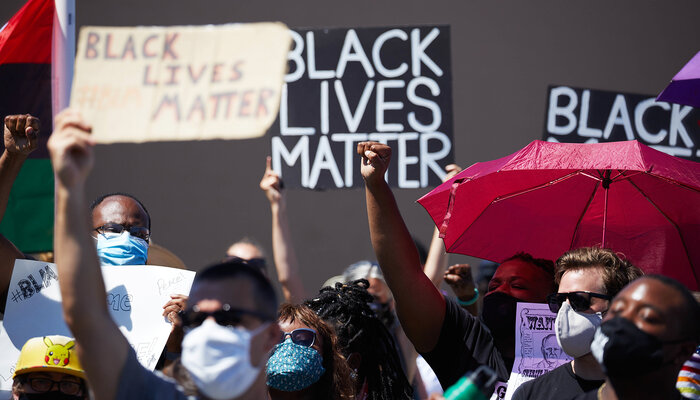The protests that followed the police killing of George Floyd in late May prompted allegations of infiltration by out-of-state anti-fascist agitators (which have been refuted) and white supremacists (which have been borne out). But little attention has been paid to a third group of infiltrators: police. As with so many other police practices that are now coming under scrutiny, the longstanding practice of using undercover police to monitor protests and protest movements should be closely examined — and reconsidered.
There is solid evidence that police infiltrated the recent demonstrations. A North Dakota officer posed as a protester, photographed activists, and yelled “F**k the police” while checking for guns at a Black Lives Matter protest in Fargo. Undercover officers disguised as Orthodox Jews attended anti-racism protests in New Jersey. The Texas Department of Public Safety outright acknowledged embedding undercover officers in the protests to root out “criminals.”
The idea, ostensibly, is that plainclothes officers can overhear people conspiring to commit violence or other illegal acts and disrupt their plots. But this rationale falls apart on closer examination. The notion that there were coordinated plans to engage in illegal activity turns out to be false. An internal Department of Homeland Security intelligence assessment found that most of the violence at protests has been committed by opportunists interested in looting, not agitators or extremists.
The benefits of infiltration are thus speculative at best. On the other hand, there are proven downsides. Indeed, undercover officers sometimes initiate or enable violence between police and protesters, further escalating the already-violent policing of dissent — a problem that is particularly pertinent for anti-police brutality and Black-led protests, which meet especially forceful resistance from law enforcement.
Additionally, the history of police infiltration is one of the government disproportionately targeting progressive activists and movements — sometimes even going so far as to gin up violence as justification for scrutiny — rather than keeping protesters safe.
Take, for instance, the FBI’s Counter Intelligence Program, known as COINTELPRO. From 1956 to 1971, it targeted groups that the government deemed subversive, with methods including unconstitutional surveillance and infiltration. Included in its mission were efforts to “expose, disrupt, misdirect, discredit, or otherwise neutralize the activities” of the Black Panthers and other Black nationalist groups. COINTELPRO was designed explicitly to target Black activists because of their political stances. One of its ignominies involved an FBI informant providing Black Panthers with sticks of dynamite to blow up the Statue of Liberty.
Or take the more recent example of the protests surrounding President Trump’s inauguration. As part of an investigation into a potential conspiracy to foment violence, police officers infiltrated a small group called Disrupt J20 that was planning meetings for the demonstrations. They followed up by arresting more than 200 anti-capitalist and anti-fascist activists, journalists, and legal observers en masse, simply because the individuals were in the vicinity of acts of property damage. The resulting prosecutions cases ended in mistrials, dismissals, and acquittals over the next 18 months. And while law enforcement agencies focus their infiltration on the advocacy of left-leaning groups, Black protesters, and Muslims, they continue to pay insufficient attention to the United States’ many violent white supremacist threats.
Police infiltration of protests also has a chilling effect on protesters’ First Amendment rights. Fear of plainclothes police joining protests to surveil activists, the danger to undocumented immigrants of Immigration and Customs Enforcement officers’ attendance at protests, the presence of agents-provocateur, and the resulting distrust of one’s fellow protesters all discourage would-be marchers from participating.
These significant risks and harms outweigh any marginal benefit that might accrue from police infiltration, at least as it has been practiced up to now. It is apparent that the use of undercover officers at protests needs to be revisited.
At a minimum, there should be more transparency and accountability accompanying the use of undercover police in protests. One model for this is the wave of surveillance oversight legislation being passed across the nation, most recently in the form of the POST Act in New York City. The measure will require the New York City Police Department to disclose basic information about the surveillance tools it uses, the deployment of those tools, and safeguards for New Yorkers’ civil liberties. Analogous legislation requiring police departments to develop and share policies regarding infiltration operations, including specific protections for protesters’ First Amendment rights, could increase their accountability to the communities they are intended to serve.
A more far-reaching approach would be to adapt and expand the recommendations of the Church Committee — a Senate panel that investigated the abuses of various intelligence authorities, including COINTELPRO — by law enforcement. The recommendations in the committee’s landmark 1976 report focused on raising the threshold for intelligence collection by shifting the focus from association and advocacy to demonstrated dangerous conduct. A similar approach could be adopted in the context of police infiltration of protests — for instance, by limiting its use to cases in which there is a preexisting investigation based on facts that support reasonable suspicion of criminal activity.
It is not clear, however, that raising the threshold would solve the problem. In Washington, DC, the 2004 First Amendment Rights and Police Standards Act already requires police to obtain clearance from top police officials, along with evidence of a threat of violence, for infiltration of advocacy groups — and those measures did not prevent the J20 debacle. And the city’s auditor had previously raised concerns about police noncompliance with the law.
A broader solution is to simply prohibit plainclothes police from attending protests. Using undercover police in connection with protests and protest movements can only further undermine trust between law enforcement and communities at a time when that trust has already been badly eroded by repeated, high-profile instances of racialized police brutality. Whatever the merits and drawbacks of undercover operations in other settings, protests are one context where people should feel free to come together and express themselves without fear of surreptitious law enforcement monitoring.

